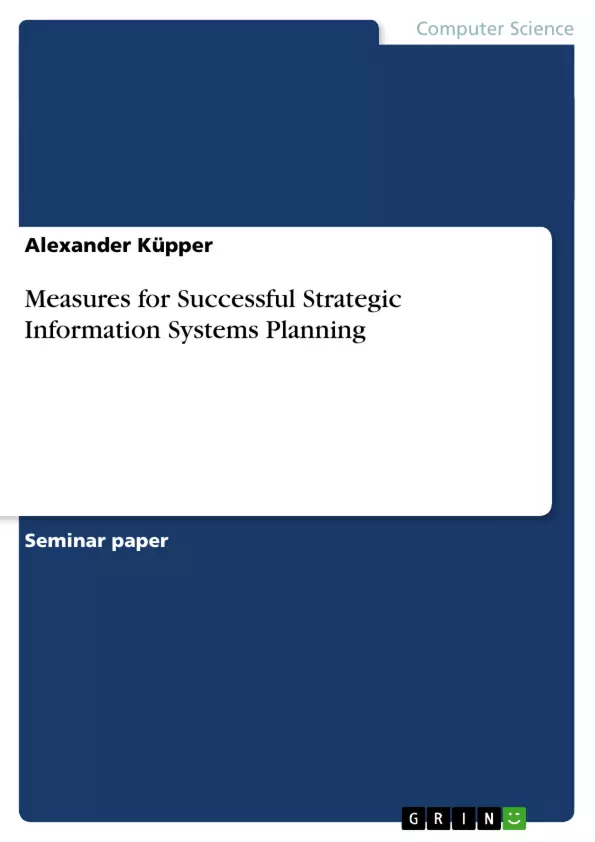Given that SISP evaluation in practice is either not applied to a satisfying degree or SISP frameworks are not implemented in accordance with literature (Grover & Segars, 2005, pp. 761-763), it appears advisable to generate a better understanding of the connection between SISP and its evaluation through bringing the existing success measures down to a common theoretical basis. In this context, three universal SISP framework dimensions form such common basis and are connected with
SISP evaluation measures (King, 1978). Through this approximation of SISP frameworks and SISP evaluation, this paper aims to investigate the validity of the dimensions for SISP measures. The transfer of SISP framework dimensions to SISP
evaluation measures provides guidance to the implementation of SISP evaluation measures in existing frameworks in a company, as well as it encourages further research to generate a more sophisticated conceptualisation of SISP evaluation methods.
Altogether, the objective of this paper is to identify the need for SISP evaluation measures, present different SISP evaluation methods and to investigate the applicability of universal SISP framework dimensions of King’s (1978) analysis.
Inhaltsverzeichnis (Table of Contents)
- Introduction
- Topic Identification
- Course of Investigation
- Research Objective
- Strategic Information Systems Planning
- Terminology
- Conceptual Framework
- Introduction to Strategic Information Systems Planning
- Successful Strategic Information Systems Planning
- Importance of Strategic Information Systems Planning
- Success in Strategic Information Systems Planning
- Approaches to Strategic Information Systems Planning Evaluation
- Measures of Evaluating Success in Strategic Information Systems Planning
- Conceptual Evaluation Approach to Strategic Information Systems Planning
- Operative Evaluation Approach to Strategic Information Systems Planning
- Analysis of Evaluation Measures
- Summary
Zielsetzung und Themenschwerpunkte (Objectives and Key Themes)
This paper aims to investigate the need for, and provide guidance on, evaluating Strategic Information Systems Planning (SISP) activities within organizations. It seeks to address the lack of clear and consistent methodologies for evaluating SISP, which often leads to inconsistent implementation and difficulty in measuring success. The paper highlights the importance of considering the unique characteristics and goals of each organization when developing evaluation frameworks.
- Importance and necessity of evaluating Strategic Information Systems Planning (SISP)
- The lack of consistent methodologies for evaluating SISP
- Developing customized SISP evaluation frameworks tailored to specific organizational structures and goals
- Identifying and analyzing different approaches to SISP evaluation
- Bridging the gap between theoretical SISP concepts and practical implementation
Zusammenfassung der Kapitel (Chapter Summaries)
The first chapter introduces the topic of Strategic Information Systems Planning (SISP) and highlights the challenges associated with its implementation and evaluation. It discusses the lack of clear guidelines and consistent methodologies for evaluating SISP, which hinders its effective application. The chapter also identifies a need for a more comprehensive understanding of SISP evaluation to ensure its alignment with organizational goals and structures.
Chapter two defines key terms and concepts related to SISP, including the role of the Chief Information Officer (CIO) and the importance of aligning SISP with business activities. It presents a conceptual framework for understanding SISP and introduces three universal SISP dimensions to facilitate further analysis of evaluation measures.
Chapter three delves into the importance of successful SISP and outlines the various approaches to evaluating its effectiveness. It emphasizes the need for comprehensive evaluation frameworks that consider both conceptual and operational aspects of SISP implementation.
Chapter four examines different measures of evaluating success in SISP and classifies them into two groups: conceptual and operative approaches. This classification serves as a basis for analyzing the strengths and limitations of different evaluation measures and provides a foundation for developing customized SISP evaluation methodologies.
The paper concludes with a summary that reinforces the importance of customizing SISP evaluation frameworks based on individual organizational needs and goals.
Schlüsselwörter (Keywords)
Strategic Information Systems Planning (SISP), evaluation methodologies, SISP success, Chief Information Officer (CIO), organizational structures, conceptual framework, evaluation measures, customized frameworks.
- Quote paper
- B.Sc. Alexander Küpper (Author), 2007, Measures for Successful Strategic Information Systems Planning, Munich, GRIN Verlag, https://www.grin.com/document/86641



